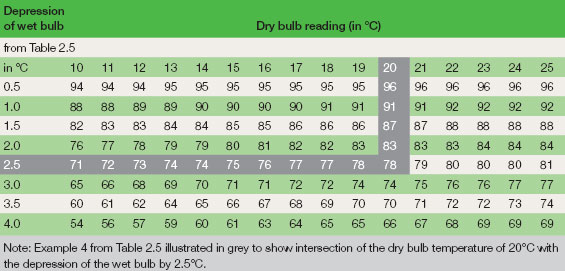Humidity is the amount of water vapour held in the atmosphere. In
everyday language it is something described as 'close' (warm and
sticky), 'dry' (little water in the air), 'damp' (cool and moist) and
'buoyant' (comfortable atmosphere). It is usually expressed more
accurately in terms of relative humidity (see below).
 |
Figure 2.14 Whirling
hygrometer with
calculator. |
The
whirling hygrometer (psychrometer) is the most accurate portable
instrument used for taking air measurements (see Figure 2.14). The wet
and dry bulb thermometers are mounted such that they can be rotated
around a shaft held in the hand, rather like a football rattle. Whilst the
dry bulb gives the actual temperature of the surroundings, the wet bulb
temperature is depressed by the evaporation of the water on its surface
(the same cooling effect you feel when you have a wet skin). The drier
the air, the greater the cooling effect, i.e. a greater wet bulb depression.
The relative humidity is calculated using hygrometric tables after the
full depression of the wet bulb temperature has been found (see example
below).
Hygrometers made out of hair, which lengthens as the humidity
increases, are also used to indicate humidity levels. These can be
connected to a pen that traces the changes on a revolving drum carrying
a hygrogram chart. Other hygrometers are based on the moisture
absorbing properties of different materials including the low technology
'bunch of seaweed'.
Relative Humidity
The quantity of water vapour held in the air depends on temperature, as shown below:
| |
0°C
10°C
20°C
30°C |
3 g of water per kilogram of air
7 g
14 g
26 g |
The maximum figure for each temperature is known as its saturation point or
dew point, and if such air is cooled further, then water
vapour condenses into liquid water. One kilogram of saturated air at 20°C would give up 7 g of water as its temperature fell to 10°C.
Indoors this is seen as 'condensation' on the coolest surfaces in the vicinity. Outdoors it happens when warm air mixes with cold air.
Droplets of water form as clouds, fog and mist; dew forms on cool surfaces near the ground. If the air is holding less than the maximum
amount of water it has
drying capacity i.e. it can take up water from its surroundings.
One of the most commonly used measurements of humidity is relative humidity (RH) which is the ratio, expressed as a percentage, of
the actual quantity of water vapour contained in a sample of air to the amount it could contain if saturated at the dry bulb temperature.
This is usually estimated by using the wet and dry bulb temperatures in conjunction with hygrometric tables.
- If the absolute humidity for air at 20°C (on the dry bulb) is found to be 14 g/kg this compares with the maximum of 14 g that can be
held when such air is saturated. Therefore, the RH is 100 per cent.
- It can be seen that RH falls to 25 per cent when the wet bulb depression shows only 3.5 g of water are present. This means that its
drying capacity has increased (it can now take up 10.5 g of water before it becomes saturated).
- An example of working out the relative humidity from wet and dry bulb measurements is given below in Tables 2.5 and 2.6 . In
example 4, when the dry bulb reading is 20°C and the depression of the wet bulb is 2.5°C then the relative humidity is 78 per cent.
 |
| Table 2.5 Calculation of relative humidity from wet and dry bulb measurements |
 |
| Table 2.6 Determination of relative humidity from the wet bulb depression |







